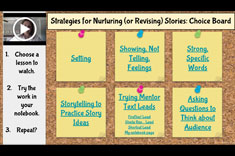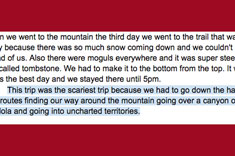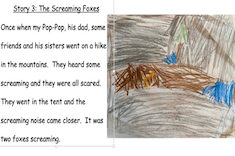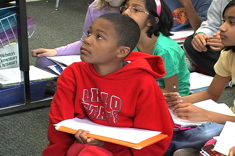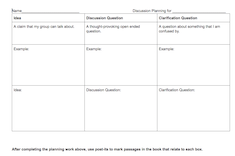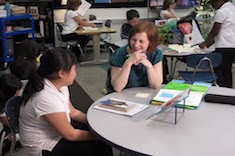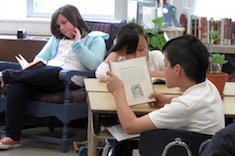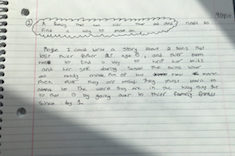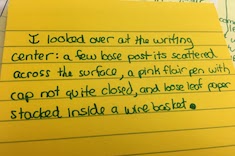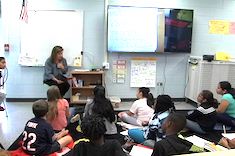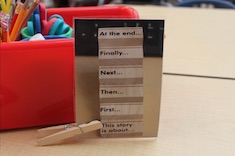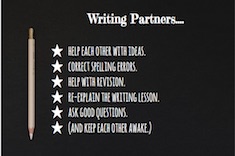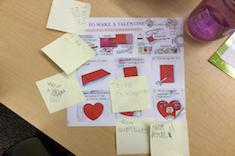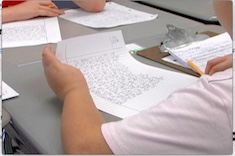Teaching Writing
Everyone who writes for Choice Literacy loves teaching writing, because we all write ourselves. We know it is "hard fun," as Donald Murray famously said—exasperating and exhilarating at the same time. The writing workshops you will read about here and see in our videos are busy, noisy, vibrant places. And most days, we wouldn't want to be anywhere else than in the midst of 'em! Here is where you'll find our latest discoveries, insights, and occasional boneheaded mistakes in teaching writing.
Latest Content
Four Notebook Pages to Scaffold Persuasive Writing
Ruth Ayres suggests four notebook pages to help students balance facts and emotions when writing persuasively.
Field Notes: 6 Ways to Respond Remotely to Build a Community of Writers
Ruth Ayres observes a writing workshop that is remote. She reflects on the ways students offer feedback and how their community of writers is established.
Choice Boards for Writing Workshop
Tara Barnett and Kate Mills give a step-by-step guide for creating choice boards in writing workshop.
Writing Work Plans
Brian Sepe empowers students to make their own plans during writing workshop.
Troubleshooting Difficulties When Writing a Big Idea in Memoir
Kate Mills and Tara Barnett pinpoint common difficulties in sixth-grade memoir. They share teaching points and student writing samples before and after revision.
Making Something Together: Shared Writing Online
Tammy Mulligan finds shared writing is her go-to strategy for teaching young learners online.
It’s Not Wrong. It’s Almost Right.
Melanie Quinn reconsiders how she teaches spelling in her fourth-grade classroom, establishing a new whiteboard routine.
Using Humor to Teach Language Standards
Teaching parts of speech is viewed as dreary work for most teachers. Melanie Meehan shares how you can infuse some fun into it with a little bit of humor.
Preparing for Book Club Discussions
Tara Barnett and Kate Mills find that book clubs succeed when students are given thoughtful tools to prepare for them.
See Your Students
Shari Frost explains why the simple act of “seeing” students can have such a potent effect in building a community of learners.
Varying Workshop Structures to Meet Student Needs
Tara Barnett and Kate Mills give guidance and support for varying the structures and routines in literacy workshops.
Sparking Ideas for Realistic Fiction
Tara Barnett and Kate Mills explain how they use examples from YA authors of how to mine everyday life for powerful ideas. They then help students move from ideas to blurbs as they start their realistic fiction drafts.
Out of Sight, Out of Mind: Accountability for Young Writers
Stella Villalba teaches young writers about writer’s craft. So how come evidence of learning from the minilessons isn’t showing up when she confers with her students? She decides to develop a plan to help students link craft lessons with their writing.
Student Ownership of Literary Analysis
Christy Rush-Levine shares the strategies she uses to help her middle school students take ownership of their literary analysis essays.
Getting Students in the Learning Zone
The zone of proximal development (or ZPD) is the sweet spot for learning—just enough challenge with just enough support to take on the challenge. Melanie Meehan shares how teachers can create scaffolds in their classrooms that help students find their own ZPDs.
First-Grade Writing Share: Highlighting Craft
Bitsy Parks leads a writing share early in the year, presenting three student examples of writing and highlighting different aspects of writer’s craft linked to minilessons.
Dealing with Lists in Style
Polysyndeton, asyndeton—if you are a writer and a word nerd, you will love Gretchen Schroeder’s suggestions for helping your students create lists with style in their writing.
Studying Craft and Punctuation in Sentences from Read Alouds
Tara Barnett and Kate Mills share the power of teaching writer’s craft in bite-sized chunks, through careful study of mentor sentences in read alouds.
I’m Done! What’s Next?
Tammy Mulligan contemplates the unique pleasure of finishing a piece of writing, as well as the challenges of helping students figure out what’s next.
Making Paper Packets for Distance Learning
Tara Barnett and Kate Mills write about the challenge of creating meaningful print-based packages of materials for students who don’t have internet access for remote learning.
Journals or Writers’ Notebooks?
Journals? Writers’ Notebooks? Shari Frost shares tips and strategies for explaining the difference between the two for teachers, as well as professional development resources.
Building Primary Writing Skills Through Character Study
Jennifer Allen upends the normal routines in a primary writing workshop to introduce students to a compelling character.
Minilesson: Revising Writing
Dana Murphy leads a minilesson in fifth grade on revising narrative writing.
Teaching Transition Words
Tara Barnett and Kate Mills work with a second-grade team to think through how best to teach transition words during a fairy tale unit, especially to students who are English learners.
Writing Partners
Partner work is an essential component of many literacy workshops. Dana Murphy explains how she is intentional in building thoughtful routines and expectations for partner work in her fifth-grade classroom.
Writing Partner Feedback in Fifth Grade
Fifth-grade writers in Franki Sibberson’s classroom encourage each other and suggest revisions to their opinion-writing drafts in partner teams.
Writers Make Plans
Tammy Mulligan considers the rituals she has for preparing to write, and then uses what she learns in classroom writing workshops.
A Quick How-to Writing Unit in First Grade
Bitsy Parks uses the short stretch before the holidays for a quick and fun how-to writing unit with her first graders.
Mentor Text Craft Guides
Melanie Meehan helps students see the craft moves in mentor texts by tucking brief guides into many of her favorite children’s books in the classroom library.
Fifth-Grade Small Group: Paragraphs
Dana Murphy meets with a group of fifth graders to help students develop paragraphing skills, using a peer’s mentor text.
Browse Content By
Type
Category
- Assessment Tools
- Big Fresh Archives
- Booklists
- Choice Numeracy
- Classroom Design
- Common Core
- Community Building
- Conferring
- Content Literacy
- Digital Literacy
- English Language Learners
- Equity
- Family Relations
- Free Samples
- Guiding Groups
- Leadership
- Literacy Coaches
- Mentor Texts
- Minilessons
- New Teacher Mentors
- Podcasts
- Poetry
- Quote Collections
- Reading Strategies
- Self Care
- Struggling and Striving Learners
- Talking and Listening
- Teacher Study Groups
- Teaching Reading
- Teaching Writing
- Word Study and Vocabulary
Author
- Melissa Quimby
- Nawal Qarooni
- Gwen Blumberg
- Julie Cox
- The Lead Learners
- Hannah Tills
- Josie Stewart
- Ruth Metcalfe
- Mallory Messenger
- Becca Burk
- Jodie Bailey
- Vivian Chen
- Mary Brower
- Tiffany Abbott Fuller
- Stephanie Affinito
- Ruth Ayres
- Leigh Anne Eck
- Heather Fisher
- Shari Frost
- Julie Johnson
- Suzy Kaback
- Gigi McAllister
- Shirl McPhillips
- Melanie Meehan
- Cathy Mere
- Debbie Miller
- Tara Barnett and Kate Mills
- Tammy Mulligan
- Dana Murphy
- Bitsy Parks
- David Pittman
- Brenda Power
- Heather Rader
- Matt Renwick
- Mandy Robek
- Christy Rush-Levine
- Gretchen Schroeder
- Jen Schwanke
- Brian Sepe
- Katherine Sokolowski
- Stella Villalba
- Jennifer Vincent
Grade Level
Choice Literacy Membership
Articles
Get full access to all Choice Literacy article content
Videos
Get full access to all Choice Literacy video content
Courses
Access Choice Literacy course curriculum and training



